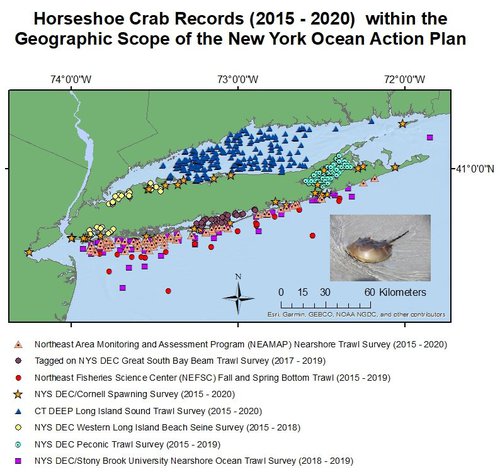Our Marine Program
In 2013, collaborations began with the New York State Department of Environmental Conservation's Division of Marine Resources to apply NatureServe methodology to marine species and natural communities. Two marine staff were added to the Zoology program in 2016 to lead the expansion and related projects.
These efforts were identified in the ten-year Ocean Action Plan that was introduced in 2017. The OAP framework fosters coordination amongst New York organizations to carry out 61 actions that together maintain the resiliency of the state’s ocean resources and the services they provide.
Methodology and Mapping

We work collaboratively with NatureServe and other network programs to adapt existing NatureServe methodology to marine species. This on-going process currently focuses on the application of ranking guidelines and also mapping occurrences of ecologically significant species like horseshoe crabs.
Our natural community classification and mapping has focused to date on marine eelgrass meadows, backbarrier lagoons, and coastal salt ponds. We map these significant marine natural communities by conservation priority and availability of spatial data.
Whale Monitoring
In January 2014 an experts workshop was convened to discuss the status of whales and existing data within the Bight. Stakeholders in attendance deliberated various survey methods and the workshop report (PDF, 1.2 MB) summarized and outlined the pros and cons. Ultimately, a monthly aerial survey and year-round passive acoustic survey were chosen.
In October 2020, the three-year baseline monitoring portion of the New York Bight Whale Monitoring Program was completed. The vital data collected will be used as the foundation for a future long-term monitoring plan, as identified in the OAP. We continue to hold annual workshops to share results and review methods alongside regional experts.
Read more about our involvement with monitoring New York's whales.
Plum Island
In 2019 we worked with InnerSpace Scientific Diving to conduct preliminary habitat and biota dive surveys around Plum Island. Read our report (PDF 2.4 MB)!
Our Saltwater Future
As anthropogenic impacts continue to increase in the New York Bight, the inclusion of the marine environment in Heritage work will highlight the importance of local species and value of this area. We continue to support and conduct research that will provide high-quality data to inform management and work closely with DEC colleagues to prioritize protected species work.
Nov. 14, 2020 | Updated Jan. 29, 2021, 1:25 p.m.